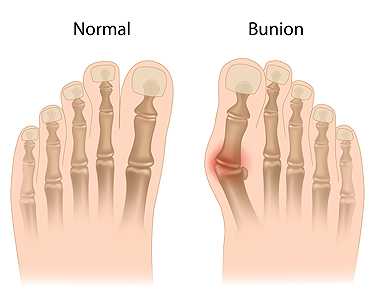
If you have ever noticed a bony protrusion at the base of your big toe, you could be dealing with a bunion. This common foot condition occurs when the first metatarsal bone gradually shifts sideways, causing the front of the foot to widen and the big toe to lean towards its companions. Symptoms can include pain at the bulging joint, along the bottom of the foot, or in the toes. The pain may become worse by wearing ill-fitting shoes, especially those that are too tight. In severe cases, bunions can lead to nerve damage, resulting in numbness, and the skin on the sole may become thick and hardened. Beyond the immediate discomfort, bunions can elevate the risk of osteoarthritis in the big toe joint, leading to chronic pain and potential instability. Genetics, weak connective tissue, and having a short Achilles tendon can contribute to the formation of bunions. In addition, short calf muscles or joint diseases such as rheumatoid arthritis can increase the risk. If you suspect you have a bunion, it is suggested that you seek the advice of a chiropodist who can help you to manage the symptoms, and mitigate the risk of complications.
Bunions progressively worsen over time and may cause walking in your shoes to become difficult. To learn more about bunions, please consult with one of the chiropodists from Complete Family Footcare & Therapy. Our clinicians will assess your condition and provide you with quality foot and ankle treatment.
What Are Bunions?
A bunion is a bony bump that protrudes from the base of the big toe. Bunions are caused due to a misalignment of the first metatarsal. The characteristic bump of a bunion forms when the metatarsal shifts outwards from its proper position. Bunions develop slowly over time and progressively worsen without treatment. The skin over the bunion may develop calluses due to the friction from shoes. Eventually, a bunion can make walking uncomfortable or even painful. Bunions are one of the most common foot deformities and are especially common in women and older adults.
Symptoms
A bunion appears as a bulging bump on the outside of the base of the big toe.
The bunion may also:
Be swollen, red, or sore
Develop corns or calluses over it
Cause pain
Limit the big toe’s range of motion
Treatment
There are several different treatments available for bunions. Conservative treatment options include wearing shoes with a wider toe box, cushioning the bunion with a specialized pad, wearing shoe inserts, icing the bunion if it becomes inflamed, and taking medications to relieve pain. In more severe cases, more invasive procedures may be done. This may involve removing the swollen tissue around the bunion, straightening the big toe, realigning the bones at the front of the foot, or a combination of these procedures.
If you have any questions, please feel free to contact our offices located in . We offer the newest diagnostic and treatment technologies for all your foot care needs
